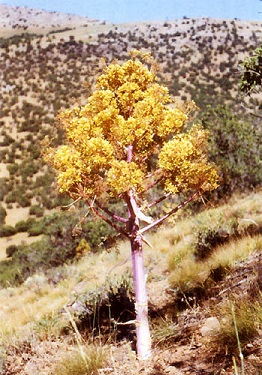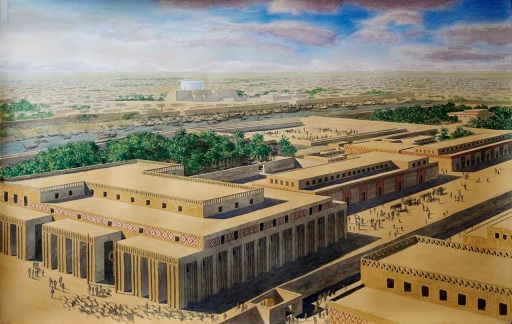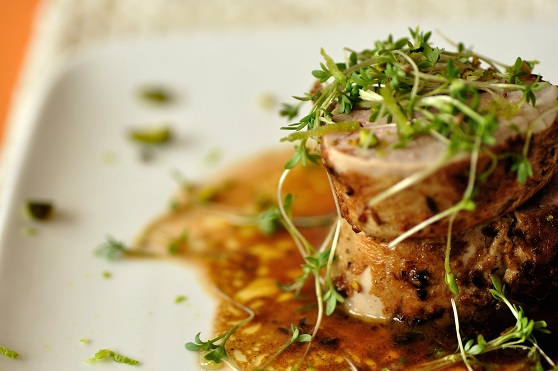God bless the Italians! An odd way to open a post about ancient Mesopotamian cuisine, I know, but so many ancient foods are still in use in the regional cuisines of Italy that it makes me want to praise them. That and today’s Mesopotamian Cookoff creation comes from the wonderful Italian cook and food blogger, Caffettiera Rosa, who concocted a terrific Pork Tenderloin with Licorice from what may be the world’s oldest recipe from Uruk found in the Archives of Erech. The recipe calls for wild licorice (Glycyrrhiza glabra), asafetida, garden cress (but possibly watercress), cumin, zest of citron, and water, and states that the cook boil six liters of water with wild licorice and cook for a long time. Then it reads that the citron zest should be added and cooked until it is reduced to 1 liter. Then the liquid is strained and meat is added and cooked. Caffettiera filled in the gaps with her culinary expertise to create the beautiful dish shown below.
She writes, “There is something utterly fascinating in cooking one of the oldest recipes in history. The food we eat and the ingredients we use are shaped by our history and by what is available to us, be it a result of nature or human intervention . . .
. . . When I think about remote places, both in time and in space, I often find I can get some grasp when thinking about ingredients: food reminds me that those people, so far away from my daily experience, were human beings and no matter how different our lives, they still shared with me the challenge of making food taste better.
When reading the selection of recipes from the Yale tablets [and elsewhere], I could not help but being drawn to a recipe calling for liquorice and citron. Both plants are heirloom productions in Calabria, the tip of the Italian toe where my partner comes from, and where I spend most of my holidays. Calabria is one of the major licorice producers in Italy: the plant has been cultivated on industrial scale for more than three hundred years. Citrons are one of the three naturally occurring types of citrus, not created by human intervention, from which the huge variety of modern citruses originates; in Calabria, like in the rest of Italy, citrons brighten up winter days, sold in tall piles at every street corner. Both ingredients are quite out of fashion in modern cooking now, but to an Italian, they are familiar.
Candied citron peel features in almost all traditional sweet recipes, and licorice sticks were one of my favourite treats as a child. At some point my sister suffered of low pressure and the doctor suggested she tried chewing licorice wood. I don’t think she ever touched one, but I for sure munched often on the bitter, and yet incredibly sweet, wood. Licorice contains a potent sweet component, several times sweeter than sugar, and a set of complex aromatics, making it a surprisingly versatile ingredient to work with. Citrons are traditionally candied, but my favourite option is to eat them raw, sliced and dressed either with sugar or with salt, pepper and olive oil. Sometimes the pulp, tart and similar to lemon, is removed; the interesting part is actually the rest: below the zest, rich of aromatic oils like all citrus fruits, there is a white part, which in other citruses is bitter and definitely inedible. In citron it is sweet and crunchy, the taste of sunny winters to me.

The recipe I chose contemplated no addition of something hot like pepper or chilli. I thought I would miss the kick, and did not expect the garden cress to be able to provide the necessary pungency, however in this particular recipe it managed to deliver it.
I had the freedom to choose what meat I wanted to use with this set of ingredients. My attention was immediately drawn to pork and duck; these meats are often paired with licorice in Chinese cooking. In the end I went for pork because I had trouble finding duck, and because somehow it reminded me of the ‘Calabrian’ theme of the other ingredients (there are very few dishes in Calabria that don’t use pork, in one form or the other). As for the cut and the cooking time, I used a technique I am quite familiar with. It may sound too ‘modern’, but the reality is that we have no clue of what this recipe was supposed to be. I’m sure the flavour mixture will work with other cuts and techniques as well and I will experiment again. I cooked the meat in butter because this is what I usually do with tenderloin and because it was a reasonable choice from an historical point of view. The result was an intriguing plate, that tastes like nothing I’ve tasted so far. It is quite appealing to the modern palate and I would not worry about guests or family not liking it; the mixture of sweet licorice, fresh citrus, pungent cress and earthy cumin was slightly bitter on its own but worked perfectly as a sauce for the meat.
I now live in Germany, so I had to play with the ingredients I can find here. I tried to find citron in every shop of my town. I couldn’t. August is probably the worst time of the year to get citruses, at least from Italy, so I was not too surprised. I substituted the zest with a mixture of fresh lime and dried orange peel, but I will try to use the real thing this winter, when I go to Calabria. I already promised several of my family members they will taste the most ancient recipe in the world.
__________
Pork Tenderloin with Licorice by Caffettiera
Ingredients
the thick end of a pork tenderloin, about 400 gr
5 licorice wood sticks, about 10 cm long
zest of a lime (see note below)
1 teaspoon dried orange powder
1/4 teaspoon asafetida
1/2 tablespoon cumin
salt
1 tablespoon butter
water
a small bunch of garden cress (see note below)
optional: pistachios, for garnish
Note 1: I substituted citron zest with a mixture of lime and dried orange zest; probably lemon would work as well. Citron zest is a little less intense, so I’d increase the quantity if I can find it.
Note 2: in Germany the only type of cress commercially available is sold in the form of tiny sprouts (see picture). I like the pungency of water cress and would have bought a small bunch of it, had I found it, to add to the sauce. Still, the garden cress was quite pungent and a crucial addition to the balance of the dish. Don’t leave it out.
Note 3: I served the dish with an arugula salad and some barley couscous. Both were available ingredients to Ancient Mesopotamia, so they are not too much of a stretch.
Directions
Start by making the licorice extract. Boil four licorice sticks in two liters of water until the water is reduced to about 1/2 liter. This took me almost an hour.
In a heavy bottomed pan dry roast the cumin seeds. Put most of them in a mortar (keep a pinch on the side for later) together with a licorice stick. Pestle until the licorice and cumin are reduced to a powder. Mix in the dried orange zest, the grated zest of a quarter of a lime, and a generous pinch of salt. Use this mixture to rub the meat using your hands. Cover with cling film and leave to rest for at least two hours, or overnight in the fridge (I left it about four hours, two in the fridge and two outside).
When the water is reduced to about a quarter of the original volume, add in the zest of half lime and a pinch of orange zest. Leave to boil for another 10-15 minutes, then leave to cool and strain. You’ll end up with 300-400 ml of licorice extract. It should taste bitter and sweet at the same time, with a fresh note from the citrus.
When almost ready to eat, melt half of the butter in a wide pan together with the reserved pinch of roasted cumin. When it is hot and foamy add the pork tenderloin and let it brown on one side for 3-4 minutes. When it is well browned turn it and repeat, until browned all over. Add about 250 ml of licorice broth, cover and let it simmer for 5 minutes. Add half of the cress and a dusting of lime zest, cover and let cook for another 2-3 minutes. Take off the meat and wrap it in foil. Turn the heat to high and let the sauce reduce, adding the remaining butter to it and scraping the bottom of the pan. Slice the meat, top with a few tablespoons of the sauce (thin it with a bit of licorice extract if it is too thick), a sprinkle of garden cress and a bit of lime zest. Sprinkle with toasted pistachios, if using, and serve straight away.”
__________
Uruk, the city that the original recipe comes from, was essentially one of the first cities in the world. In myth and literature, Uruk was famous as the capital city of Gilgamesh, and it transformed human communities from collections of agricultural villages to a city with centralized authority, a full-time bureaucracy, a military, class stratification and trade specialization.

From its formation in around 5000 – 4800 BCE, Uruk began to amass a comparatively large population in Southern Mesopotamia, owing perhaps to its placement just inland of the marshes near the head of the Persian Gulf. The environment allowed for a concentration of fisherman, farmers, gardeners, hunters and herdsman, all of whom were able to specialize their professions and increase productivity in Uruk’s sophisticated urban environment. The downside (perhaps) of this specialization is that individual families became less self-sufficient.
Through the gradual and eventual domestication of native grains from the Zagros foothills and extensive irrigation techniques, enabled Uruk’s growth into the largest Sumerian settlement, in both population and area, with relative ease. By 3400 BCE the monumental buildings as pictured in the artist’s reconstruction were built, and by 3100 BCE the earliest cuneiform writing emerged.
What we have in this recipe is nothing less than a dish from the dawn of Western Civilization that is still delicious today. (Words by Caffettiera Rosa and Laura Kelley. Photo of Pork Tenderloin with Licorice by Caffettiera Rosa; Photo of Ferula foetida “tree” in Iran by M.Rejzek; Illustration of Uruk by Balage Balogh.)

